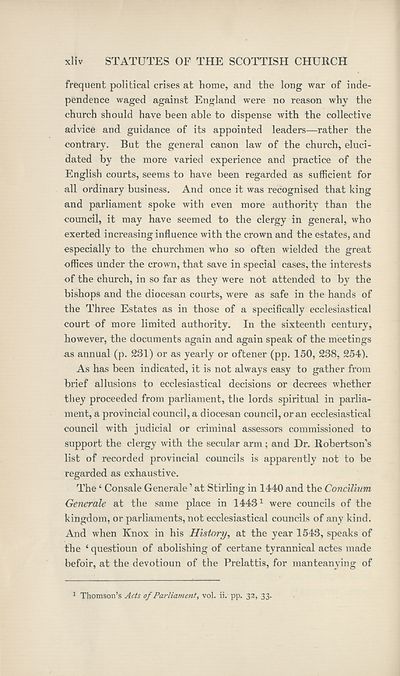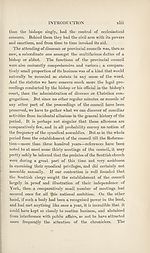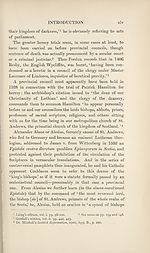Series 1 > Statutes of the Scottish Church, 1225-1559
(49) Page xliv
Download files
Complete book:
Individual page:
Thumbnail gallery: Grid view | List view

xliv STATUTES OF THE SCOTTISH CHURCH
frequent political crises at home, and the long war of inde¬
pendence waged against England were no reason why the
church should have been able to dispense with the collective
advice and guidance of its appointed leaders—rather the
contrary. But the general canon law of the church, eluci¬
dated by the more varied experience and practice of the
English courts, seems to have been regarded as sufficient for
all ordinary business. And once it was recognised that king
and parliament spoke with even more authority than the
council, it may have seemed to the clergy in general, who
exerted increasing influence with the crown and the estates, and
especially to the churchmen who so often wielded the great
offices under the crown, that save in special cases, the interests
of the church, in so far as they were not attended to by the
bishops and the diocesan courts, were as safe in the hands of
the Three Estates as in those of a specifically ecclesiastical
court of more limited authority. In the sixteenth century,
however, the documents again and again speak of the meetings
as annual (p. 231) or as yearly or oftener (pp. 150, 238, 254).
As has been indicated, it is not always easy to gather from
brief allusions to ecclesiastical decisions or decrees whether
they proceeded from parliament, the lords spiritual in parlia¬
ment, a provincial council, a diocesan council, or an ecclesiastical
council with judicial or criminal assessors commissioned to
support the clergy with the secular arm; and Dr. Robertson’s
list of recorded provincial councils is apparently not to be
regarded as exhaustive.
The ‘ Consale Generale ’ at Stirling in 1440 and the Concilium
Generale at the same place in 14431 were councils of the
kingdom, or parliaments, not ecclesiastical councils of any kind.
And when Knox in his History, at the year 1543, speaks of
the 4 questioun of abolishing of certane tyrannical actes made
befoir, at the devotioun of the Prelattis, for manteanying of
1 Thomson’s Acts of Parliament, vol. ii. pp. 32, 33.
frequent political crises at home, and the long war of inde¬
pendence waged against England were no reason why the
church should have been able to dispense with the collective
advice and guidance of its appointed leaders—rather the
contrary. But the general canon law of the church, eluci¬
dated by the more varied experience and practice of the
English courts, seems to have been regarded as sufficient for
all ordinary business. And once it was recognised that king
and parliament spoke with even more authority than the
council, it may have seemed to the clergy in general, who
exerted increasing influence with the crown and the estates, and
especially to the churchmen who so often wielded the great
offices under the crown, that save in special cases, the interests
of the church, in so far as they were not attended to by the
bishops and the diocesan courts, were as safe in the hands of
the Three Estates as in those of a specifically ecclesiastical
court of more limited authority. In the sixteenth century,
however, the documents again and again speak of the meetings
as annual (p. 231) or as yearly or oftener (pp. 150, 238, 254).
As has been indicated, it is not always easy to gather from
brief allusions to ecclesiastical decisions or decrees whether
they proceeded from parliament, the lords spiritual in parlia¬
ment, a provincial council, a diocesan council, or an ecclesiastical
council with judicial or criminal assessors commissioned to
support the clergy with the secular arm; and Dr. Robertson’s
list of recorded provincial councils is apparently not to be
regarded as exhaustive.
The ‘ Consale Generale ’ at Stirling in 1440 and the Concilium
Generale at the same place in 14431 were councils of the
kingdom, or parliaments, not ecclesiastical councils of any kind.
And when Knox in his History, at the year 1543, speaks of
the 4 questioun of abolishing of certane tyrannical actes made
befoir, at the devotioun of the Prelattis, for manteanying of
1 Thomson’s Acts of Parliament, vol. ii. pp. 32, 33.
Set display mode to:
![]() Universal Viewer |
Universal Viewer | ![]() Mirador |
Large image | Transcription
Mirador |
Large image | Transcription
Images and transcriptions on this page, including medium image downloads, may be used under the Creative Commons Attribution 4.0 International Licence unless otherwise stated. ![]()
| Scottish History Society volumes > Series 1 > Statutes of the Scottish Church, 1225-1559 > (49) Page xliv |
|---|
| Permanent URL | https://digital.nls.uk/126917574 |
|---|
| Attribution and copyright: |
|
|---|
| Description | Over 180 volumes, published by the Scottish History Society, containing original sources on Scotland's history and people. With a wide range of subjects, the books collectively cover all periods from the 12th to 20th centuries, and reflect changing trends in Scottish history. Sources are accompanied by scholarly interpretation, references and bibliographies. Volumes are usually published annually, and more digitised volumes will be added as they become available. |
|---|


